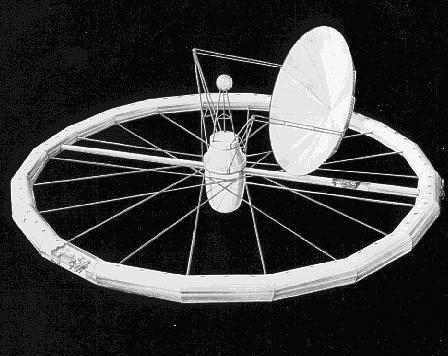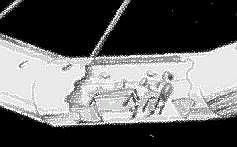
Home - Search - Browse - Alphabetic Index: 0- 1- 2- 3- 4- 5- 6- 7- 8- 9
A- B- C- D- E- F- G- H- I- J- K- L- M- N- O- P- Q- R- S- T- U- V- W- X- Y- Z
Von Braun Station

Von Braun station
Space station as sketched by Von Braun for the US Army in 1946.
Status: Study 1945.
The design, a toroidal station spun to provide artificial gravity, would be made very familiar to the American public over the next six years. The design was elaborated at the First Symposium on Space Flight on 12 October 1951 at the Hayden Planetarium in New York City. The design was popularized in the series in Colliers magazine, illustrated with gorgeous Chesley Bonestell painting, in 1952.
The 1946 version used 20 cylindrical sections, each about 3 m in diameter and 8 m long, to make up the toroid. The whole station was about 50 m in diameter and guy wires connecting and positioning the toroid to the 8 m-diameter central power module. This was equipped with a sun-following solar collector dish to heat fluid in a ball-shaped device. The heated fluid would run an electrical generator. Presumably visiting spacecraft would dock or transfer crew at the base of the power module. Two narrow transfer tubes allowed the crew to move between the living and work quarters in the toroid and the power module.
In the 1952 version as described by Willy Ley, the station was enlarged to 75 m diameter and housed 80 crew. The station's toroid was no longer made of cylindrical sections, but was a smooth donut-shape of inflatable sections made of reinforced rubber. The station would embody much new technology, and would take at least ten years to develop and build after go-ahead. The station would rotate to produce 1 G of artificial gravity at the crew levels. The outermost level would be dedicated to utilities (ducts, wiring, and piping of the water distribution and balance system). There would be two full-height living and working levels. Small space taxis would be used to move from docking ports at the center of the rotating station to arriving space shuttles, and to conduct assembly operations of moon- or Mars-bound spacecraft near the station. Sections of the station would be dedicated to communications (space-to-space and space-to-earth), meteorology, terrestrial and military observations, a digital computer (expected to be much reduced in mass and power requirements from its 1952 contemporaries!), environmental control and water purification equipment. A metal meteoroid shield, set out 3 cm from the station's outer surface, would protect the station's inflated plastic torus.
The station would be in a 1730-km circular 2-hour orbit (this orbit was later found to be within the then-unexpected Van Allen radiation belts and therefore unusable by a manned spacecraft). The orbit would be pseudo-sun-synchronous, coasting along the terminator, perpetually in sunshine as the earth revolved below it. The space taxis would be used to adjust the orbit daily to keep it in this position throughout the year. The sun-facing side of the station would be equipped with a solar concentrator trough, parabolic in cross section, which would heat tubes containing mercury, that would drive a turbine to generate electricity, then be cooled, condensed, and pumped back to the concentrator. A nuclear reactor power source was ruled out on grounds of weight, and the fact it would also require a thermal generator circuit of similar or greater complexity. The solar generator was rated at 1660 kW thermal to produced 500 kW of electrical power. The mercury would be heated to 700 deg C and a pressure of 50 kg/sq cm.
The station would have a total volume of 18,400 cubic meters, normally requiring 24 metric tons of a nitrogen/oxygen air mixture for pressurization. Use of a helium/oxygen atmospheric mixture would reduce the total mass of atmosphere aboard the station to 16 metric tons and also eliminate the risk of bends in case of depressurization. The crew of 80 persons would normally require 110 kg of oxygen per day. Use of blue green algae to convert the carbon dioxide exhaled by the crew to oxygen would nearly eliminate the oxygen resupply requirement. The algae tanks to accomplish this would have to have a total of 23 square meters exposed surface, be 3 cm deep, and contain one liter of algae and three liters of water per square meter.
Exhaled and urinated water would also be purified and reused. All of these measures would reduce resupply requirement s to 225 kg per day for the entire 80-man crew. Reserve supplies for 6 to 8 weeks would be replenished and kept aboard at all times. In case daily shuttle service was interrupted by an attack at the launch base on Christmas Island, as little as three launches every four months, each with a 33 metric ton payload, would be sufficient to resupply the station.
Crew Size: 80.
Family: Space station, Space station orbit, USA - Space Stations. People: von Braun. Country: USA. Launch Vehicles: V-2. Bibliography: 16.
 | 1946 Station Close-up of cutaway section of space station as sketched by Von Braun for the US Army in 1946. |
1945 - During the year - . LV Family: V-2. Launch Vehicle: A9/A10/A11, A9/A10/A11/A12.
- Von Braun documents plans for future uses of rocket power. - .
Nation: Germany.
Related Persons: von Braun.
Spacecraft: Von Braun Station.
As part of a summary of his work on rockets during World War II, Wernher von Braun speculated on future uses of rocket power. These included an observatory in space, the construction of space stations in earth orbit, a space mirror, and interplanetary travel, beginning with trips to the moon.
1946 During the Year - .
- Von Braun prophesied the construction of space stations in orbit. - . Nation: USA. Spacecraft: Von Braun Station. In the first 1946 summary of his work during World War II, Wernher von Braun proposed a toroidal station spun to provide artificial gravity..
1949-1952 - .
- Awakening public interest in the United States and in Europe in manned spaceflight. - .
Nation: USA.
Related Persons: Clarke,
Haber,
Ley,
von Braun,
Whipple.
Spacecraft: Von Braun Station.
Awakening public interest in the United States and in Europe was manifested by publication in September 1949 of The Conquest of Space by Willy Ley. Ley featured detailed descriptions of orbital space stations and manned flights to the Moon and back as part of man's quest to conquer the frontier of space. The First Symposium on Space Flight was held 12 October 1951 at the Hayden Planetarium in New York City. Papers read at the Symposium were published in March 1952 by Collier's magazine under the title 'Man Will Conquer Space Soon.' Contributors were Wernher von Braun, Joseph Kaplan, Heinz Haber, Willy Ley, Oscar Schachter, and Fred L. Whipple. Topics ranged from manned orbiting space station) and orbiting astronomical observatories to problems of human survival in space, lunar space ventures, and questions of international law and sovereignty in space. Finally, Arthur C. Clarke's The Exploration of Space, first published in England in 1951 and a Book of the Month Club selection in America the following year, persuasively argued the case for orbital space stations and manned lunar and planetary space expeditions, popularizing the notion of space flight in general.
1951 October 12 - .
- First Symposium on Space Flight at the Hayden Planetarium in New York City. - . Nation: USA. Related Persons: Ley, von Braun. Spacecraft: Von Braun Station. The Von Braun rocket, space station, and lunar lander designs presented were popularised in the series in Colliers magazine, illustrated with gorgeous Chesley Bonestell paintings, in 1953..
Back to top of page
Home - Search - Browse - Alphabetic Index: 0- 1- 2- 3- 4- 5- 6- 7- 8- 9
A- B- C- D- E- F- G- H- I- J- K- L- M- N- O- P- Q- R- S- T- U- V- W- X- Y- Z
© 1997-2019 Mark Wade - Contact
© / Conditions for Use